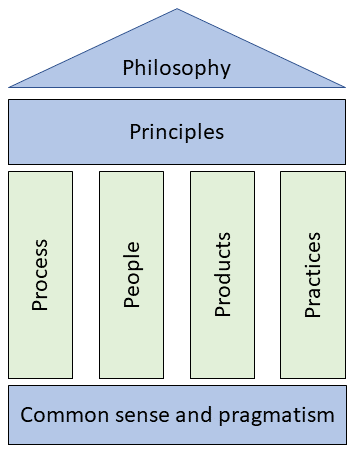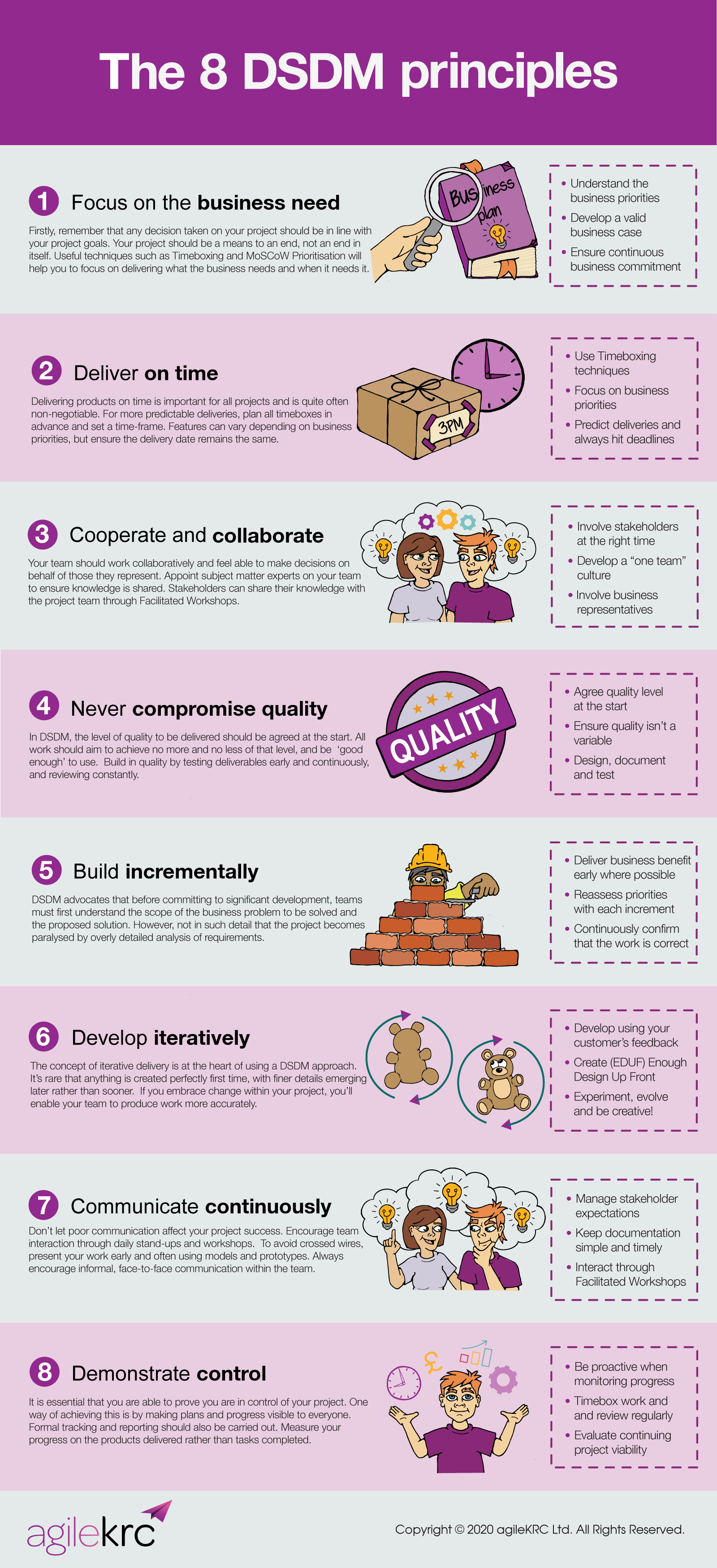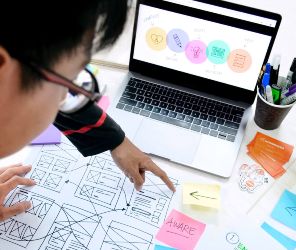
Beginnings of DSDM
DSDM, or Dynamic Systems Development Method, is often thought of as Agile’s little-known treasure.
First introduced in 1995, DSDM is the most long-standing Agile method and is unique in its focus on managing Agile projects.
Following the turn of the millennium, DSDM rose to prominence among software developers seeking alternatives to rapid application development (RAD) methodologies. One significant issue with RAD was its lack of scalability for team collaboration. By promoting teamwork and scaling, DSDM became one of the first Agile methodologies employed within the software development community.
DSDM had a role in the formation of the Agile Alliance and the Agile Manifesto in 2001. Its guiding principles and philosophy influenced the Manifesto for Agile Software Development, though DSDM extends the Agile concept well beyond software.
Simply put, DSDM was Agile before the term Agile existed!
DSDM Atern Emergence
A substantial update to the DSDM approach occurred in 2007, resulting in the creation of DSDM Atern. The name ‘Atern’ originated from the Arctic Tern, a bird celebrated for its remarkable collaboration skills and ability to travel immense distances. This symbolism was fitting for the rebranding of the DSDM method.
In 2014, due to the confusion surrounding the ‘Atern’ name, another update to the method was initiated. The choice was made to revert to the original DSDM title, which was widely recognized. As such, DSDM and DSDM Atern are now one and the same!
DSDM’s Agile Project Framework
The rebranding of DSDM in 2014 involved the implementation of the Agile Project Framework. The DSDM Agile Project Framework now stands as the leading, established agile approach that fulfills the dual necessities of contemporary organizations: both governance and strictness, along with agility and versatility.
DSDM’s Agile Project Framework aids organizations in dealing with common project setbacks like delayed completion, budget overruns, or final deliverables not being fit for their intended use.
Agile Project Management: AgilePM
DSDM became a trailblazer by being the first agile framework to incorporate agile project management capabilities. While Scrum is primarily concerned with product delivery during an iteration, DSDM also addresses the project management aspects, making it distinct from most other agile frameworks.
Due to DSDM’s capacity to meet a range of agile requirements, it was chosen as the foundation for the rapidly developing AgilePM (Agile Project Management) qualifications, accredited by APMG International and the Agile Business Consortium.
DSDM – Agile Framework Innovation
DSDM is a cyclical agile framework originally designed to execute software projects more effectively. Similar to other agile frameworks and methodologies, DSDM arose as an alternative to the problematic waterfall processes that had become common in the software development industry during the late 20th century.
DSDM’s Development
DSDM is now developing as agile methodologies evolve. This development is attributed to organizations requiring more rigor and control when implementing agile in scenarios where the ‘ideal agile environment’ is not present.
DSDM is an agile method that addresses the needs of both simple product development projects with co-located teams, and more complex projects involving multiple distributed teams working in various countries and time zones. DSDM can scale up to handle multiple teams working in dispersed environments, something that scaled agile frameworks have only recently started providing.
DSDM Details
Beyond IT-centric Approach
While DSDM’s origin, along with most agile frameworks and methods, lies in the software development industry, agile has evolved over the past decade and is no longer confined to IT.
DSDM can be easily applied to projects outside of software development. In fact, it can be implemented in any type of product development project. By delivering a usable product incrementally at the end of each timebox, DSDM can provide business value early in the product development lifecycle.
DSDM: Standalone or Integrated
The DSDM Agile Project Framework can be used either as a standalone method or integrated with other well-established project management methods such as PRINCE2, MSP, and PMI.
It is also an excellent wrapper for more limited Agile approaches like Scrum, ensuring that the entire project lifecycle is covered. DSDM also enables Scrum to be scaled up for use beyond just product development.
DSDM Structure

DSDM is an agile project framework that consists of several features:
- philosophy
- principles
- people
- products
- process
- practices
- pragmatism and common sense.
These features together foster a philosophy of delivering business benefits as early as possible, ensuring the highest return on investment (ROI) for an organization.
DSDM’s ‘sensibleness and pragmatism’ might seem strange to some, but this flexibility helps DSDM avoid the doctrinaire attitudes that can sometimes afflict other Agile approaches.
A primary tenet of DSDM is that nothing is built perfectly on the first try. Generally, 80% of a solution’s value can be delivered for 20% of the effort needed to create the entire solution.
By putting the business need at the forefront, DSDM supports projects that strategically align with an organization’s change portfolio.
DSDM principles
DSDM is built on 8 key principles that reflect its values, culture, and working style. These principles need to be actively managed at all times, as a compromised principle can threaten the successful execution and completion of a project.
DSDM closely adheres to agile principles, with a focus on delivery, effective communication, collaboration, and continuous delivery. All DSDM principles serve to align DSDM practices within the agile philosophy.
Mastering the guiding principles of DSDM is vital if you plan to pursue an agile project management course such as AgilePM®, which is based on the DSDM method.
We will now look at the 8 DSDM principles.
1. Focus on the business need
- Understand business priorities.
- Create a valid business case.
- Enable continuous business commitment.
Every decision taken during your project must be in line with the overarching project aims. Projects should act as a vehicle to achieve long-term business objectives. Approaches like MoSCoW and timeboxing help maintain focus on delivering what the business demands and when it demands it.
2. Deliver on time
- Use timeboxing.
- Focus on priorities.
- Predict deliveries.
Prompt product delivery is often a strict demand. For stable deliveries, map out all timeboxes in advance. Though features might be variable, the delivery dates should consistently stay the same.
3. Cooperate and collaborate
- Promote stakeholder collaboration.
- Focus on team building.
- Work with business representatives.
Teams should possess the ability to work in unison and make determinations for the individuals they represent. Include subject matter specialists in your team to foster the distribution of information. Regular workshops facilitate stakeholders in sharing their expertise and experiences with project teams.
4. Never compromise quality
- Set quality level at the start.
- Ensure quality doesn’t vary.
- Document and test.
At the project’s inception, set the target quality level. Endeavor to reach this agreed-upon standard in all work. Conduct early testing of deliverables and maintain ongoing scrutiny.
5. Build incrementally
- Deliver business benefit early.
- Reassess priorities with each iteration.
- Confirm that the work is correct.
DSDM dictates that teams need to fully understand the business challenge’s scope before diving into development. Refrain from becoming overly immersed in the analysis of requirements, which could stall development.
6. Develop iteratively
- Use customer feedback.
- Create Enough Design Up Front (EDUP).
- Evolve and be creative.
At the core of DSDM lies the idea of iterative delivery. Embrace the fact that it’s unusual for anything to be perfect on the first try and be open to change within your project for successful outcomes.
7. Communicate continuously
- Manage expectations.
- Keep documentation simple.
- Interact through workshops.
Stimulate teamwork by organizing stand-ups and workshops. Display your work frequently by utilizing models and prototypes. Always support informal, in-person interactions within the team.
8. Demonstrate control
- Be proactive.
- Timebox work and review regularly.
- Evaluate project viability.
Increase project control by displaying plans and progress openly for everyone. Carry out formal documentation methods. Evaluate progress by considering the products delivered, rather than completed tasks.
Processes
DSDM employs both iterative and incremental methods. The delivery of the most important business requirements occurs early, while those of lesser importance are delivered later.
By being iterative, DSDM permits business representatives to assess an evolving solution, give feedback, and suggest changes during its continued development.
Phases
The DSDM process model is made up of 6 phases. It stands out from most other Agile techniques due to the inclusion of a pre-project phase and post-project phase, which focus on more than just delivery.
The DSDM phases are:
- Pre-project.
- Feasibility.
- Foundations.
- Evolutionary development.
- Deployment.
- Post-project.
People
DSDM integrates stakeholders from both business and development sectors throughout its iterative and incremental stages.
Each person involved in a project has distinct roles and responsibilities, cooperating within timeboxes to ensure the project remains on track.
DSDM differentiates itself from other Agile approaches by outlining the project manager’s obligations.
Practices
DSDM prescribes 4 key practices.
Timeboxing
DSDM, like several other agile frameworks, schedules work in fixed time intervals (timeboxes), similar to Scrum’s sprints. The aim is to produce a working product at the end of each iteration (timebox). As such, DSDM employs both an incremental and iterative methodology for product development.
Facilitated workshops
Facilitated workshops involve project stakeholders in a collaborative effort to define business requirements and facilitate mutual understanding.
Modelling and iterative development
Modelling enables team members to visualize a business domain and enhance their comprehension of it. This approach aids in the creation of diagrammatic representations of specific components of the system or the business area under development.
To achieve an incremental working release of software at the conclusion of each iteration, DSDM depends on a brief feedback loop with the client. It advocates for the MoSCoW prioritization technique to determine which requirements the team should address during a timebox. These requirements are typically documented as user stories.
DSDM employs prototyping as well. The goal is to construct something quickly, receive prompt feedback, and identify issues earlier rather than later. The fundamental DSDM philosophy asserts that discovering and addressing problems as early as possible is preferable to making adjustments at a later stage.
MoSCoW prioritization
Utilizing the MoSCoW prioritization approach, businesses can effectively rank their requirements as Must have, Should have, Could have, or Won’t have, allowing for a structured prioritization within each timebox.
The Distinction between DSDM and Scrum
It is not uncommon for people in the Agile community to incorrectly regard Scrum as a project management method. In truth, Scrum is a development methodology that enables team collaboration on both project and non-project tasks to iteratively develop products that provide value to customers.
Scrum does not deal with the activities prior to a project (pre-project) or after the solution has been deployed (post-project). The pre-project phase requires assessing the project’s merits, while the post-project phase involves evaluating the benefits of the solution and identifying any necessary improvements.
In contrast, DSDM covers the pre-project and post-project phases and specifies the project manager’s duties. DSDM operates as an agile project management framework, while Scrum serves as a product delivery framework. Notably, Scrum can be integrated into DSDM projects during the other four project phases.
DSDM infographic
The following infographic shows the DSDM principles in greater detail.

Summary
The DSDM Agile Project Framework is a tried-and-tested approach to agile project delivery that has been effectively implemented in various projects around the world. DSDM remains the only agile project management framework available today.
The framework has consistently shown its capability to work successfully within and augment existing corporate processes.With a history spanning back to 1994, DSDM has been applied to both IT and non-IT projects, resulting in significant productivity enhancements, as independently verified by the UK Software Metrics Association.
For more insights on how DSDM can support your Agile project delivery, or for information regarding agile project management training, please contact us at agileKRC.
agileKRC has helped shape agile thinking by leading the teams that developed AgilePM® and PRINCE2 Agile®. We take a practical, success-oriented approach. We begin by taking the time to listen and understand your needs, before offering our real-world experience and expert guidance.













